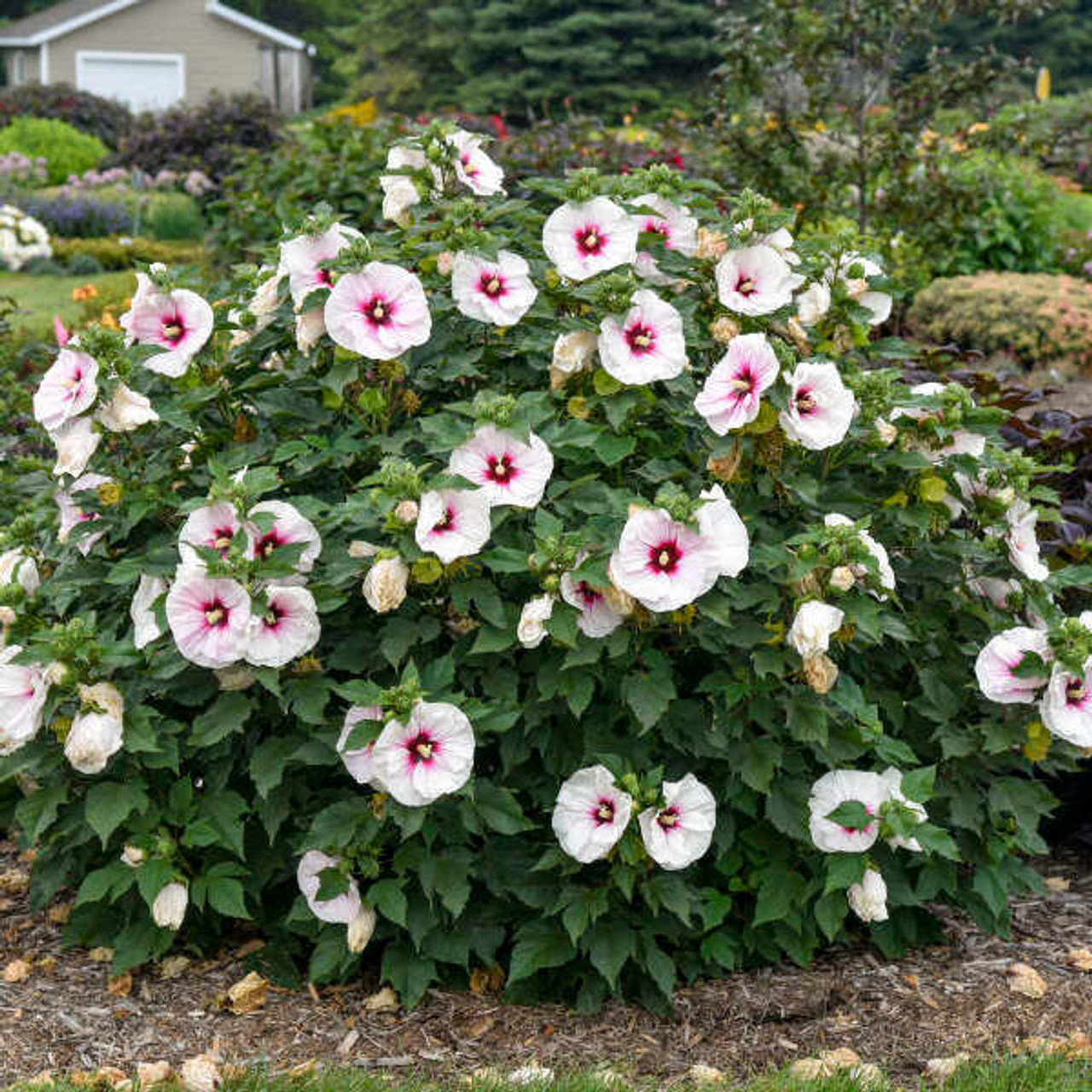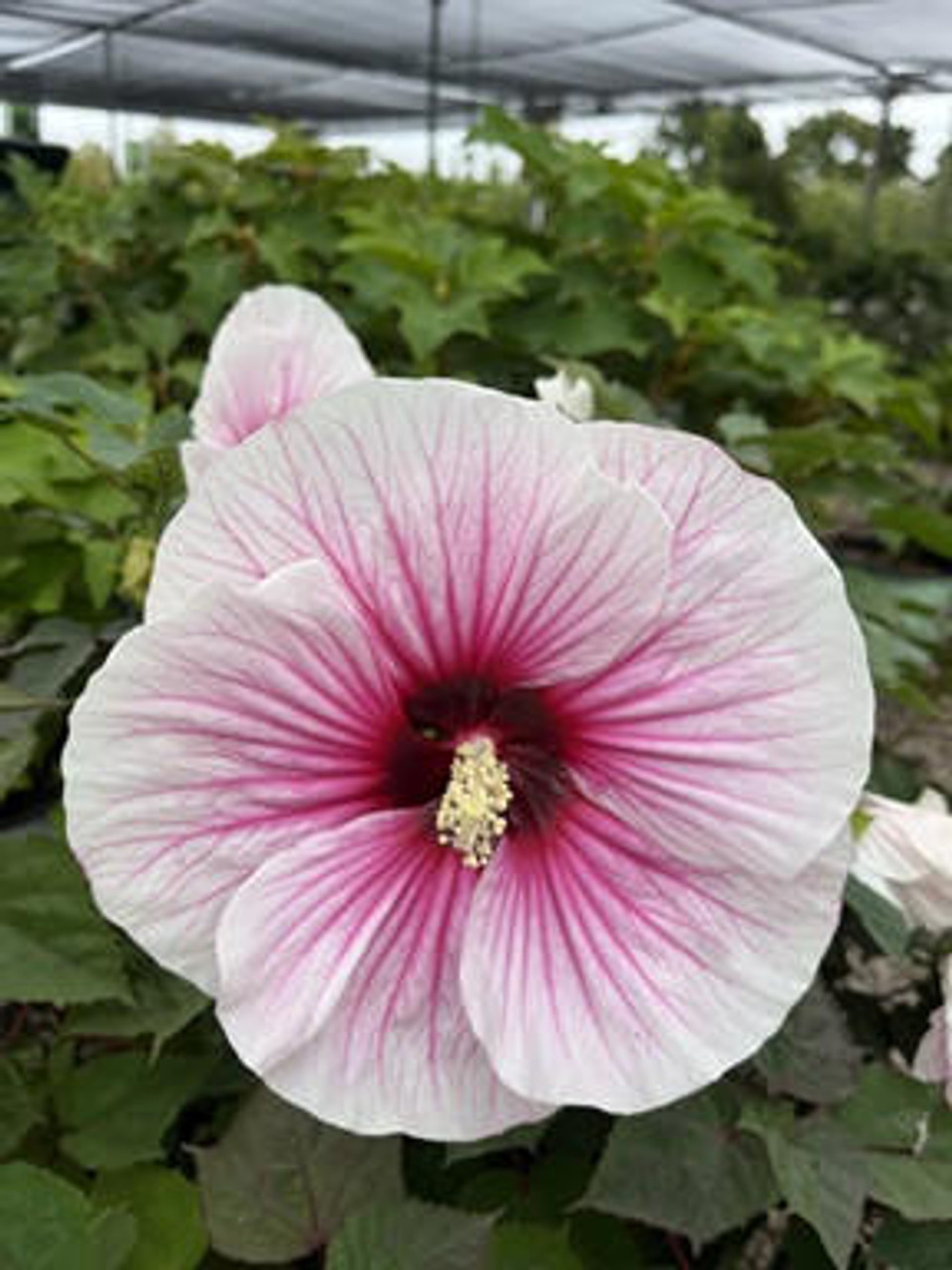Product Description
Hibiscus 'Angel Eyes' PPAF (25) Bare Root Plants
Common Name: Rose Mallow
One of the earliest Hardy Hibiscus to flower! 8" bright white flowers have raspberry red eyes that radiate out through the petals. Broad green foliage on red stems make up a well-rounded habit. Thick tuberous roots penetrate deep even the heaviest clay soils, allowing this plant to endure extended periods without water. Likewise, tolerance of mild flooding and prolonged periods of moisture make this the perfect candidate for rain gardens.
These North American native plants bring massive, tropical-looking flowers all the way to zone 4. Although later to emerge than most perennials in spring, these are fast growing plants capable of adding an inch of new growth a day. Excellent at brightening up end of season gardens.
Hibiscus love the sun and need moist, well-drained soil. Keeping these plants watered will result in larger flowers and lush foliage. Deadheading will improve the appearance of the plant. It is best to plant Hibiscus in the garden before the heat of the summer arrives, and should be heavily mulched the first winter. In spring, cut back any remaining stems before new growth appears. A strong pair of loppers or a saw will be necessary to cut this plant back. Be advised that Hibiscus is always one of the last perennials to emerge in spring. Its vigorous growth rate more than makes up for this late start, however. Japanese beetles find these plants especially delicious.
Height: 5 Feet
Spread: 5 Feet
Hardiness Zones: 4,5,6,7,8,9
Flower Color: White shades
Foliage Color: Green shades
Full Sun to Part Shade
Average to Consistent Water Needs
Poor to Fertile Soil Quality
Bloomtime: Midsummer - Late Summer
Attracts Butterflies
Bee Friendly
Deer Resistant
Growth Rate: Rapid
Attractive Foliage, Bog Plant, Border Plant, Specimen, Focal Point
Hibiscus 'Angel Eyes' is a stunning variety of rose mallow that is sure to turn heads in any garden. This hardy hibiscus is a North American native and is known for its large, white flowers with raspberry red eyes that radiate out through the petals . The flowers can grow up to 8 inches across and bloom continuously from midsummer to early fall . The plant itself is a dense, well-rounded herbaceous perennial that can grow up to 5 feet tall and wide . It has dark green, slightly serrated leaves that provide a lush backdrop to the colorful flowers.
Characteristics Hibiscus 'Angel Eyes' is a vigorous grower and can add an inch of new growth a day. It is one of the earliest hardy hibiscus to flower and is tolerant of both extended periods without water and mild flooding . This makes it an ideal choice for rain gardens . The plant is also deer resistant and attracts bees and butterflies . It typically grows up to 5 feet tall and wide and is a good choice for containers.
Care Requirements Hibiscus 'Angel Eyes' is a low-maintenance plant that is easy to care for. It prefers full sun to partial shade and moist, well-drained soil . Water regularly, especially during dry periods, but do not overwater . Fertilize once a year with a balanced, slow-release fertilizer . No pruning is required, except to prune it into a desired form . In winter, mulch around the base of the plant to protect the roots . Its thick, tuberous roots enable it to handle extended periods without water.
Growing Conditions Hibiscus 'Angel Eyes' is hardy in USDA Hardiness Zones 4 to 9 . It can be grown in a variety of soil types, including clay, loam, and sandy soil . The plant prefers a slightly acidic to neutral soil pH . It is important to protect the plant from strong winds, as the tall stems can be susceptible to damage.
Pests and Diseases Hibiscus 'Angel Eyes' can be susceptible to a number of pests and diseases. To prevent pests and diseases, ensure good air circulation around your plants and avoid overhead watering . If you do see signs of pests or diseases, treat them promptly with an appropriate insecticide or fungicide . For example, aphids can be treated with insecticidal soap or neem oil . To prevent the spread of powdery mildew, remove infected plant matter.
| Pest/Disease | Description | Treatment |
| Aphids | Small, sap-sucking insects that can cause stunted growth and yellowing of foliage. | Insecticidal soap, neem oil, or introduce natural predators like ladybugs. |
| Japanese beetles | Large, iridescent beetles that can quickly destroy plant foliage. | Hand-picking, insecticidal soap, or traps. |
| Caterpillars | Larvae of moths or butterflies that can defoliate plants. | Hand-picking, Bacillus thuringiensis (Bt), or neem oil. |
| Mealybugs | Small, soft-bodied insects that suck sap from plants. | Insecticidal soap, neem oil, or rubbing alcohol. |
| Scale | Small, rounded pests that attach to stems and suck sap. | Neem oil, insecticidal soap, or horticultural oil. |
| Spider mites | Tiny creatures that can cause yellowing foliage and premature dieback. | Blast of water, insecticidal soap, or neem oil. |
| Thrips | Small insects that can cause discoloration and premature flower drop. | Insecticidal soap, neem oil, or spinosad. |
| Whiteflies | Small, winged insects that suck sap from plants. | Insecticidal soap, neem oil, or horticultural oil. |
| Leaf spot | Dark spots on leaves, often surrounded by a yellow halo. | Remove infected leaves, improve air circulation, and avoid overhead watering. |
| Rust | Orange to brown pustules on the undersides of leaves. | Remove infected leaves, improve air circulation, and avoid overhead watering. |
| Botrytis blight | Gray mold that can affect flower buds. | Improve air circulation, avoid overhead watering, and apply fungicides. |
| Alternaria and Cercospora | Fungal diseases that can cause leaf spots. | Remove infected leaves, improve air circulation, and avoid overhead watering. |
| Myrothecium | A fungal disease that can cause leaf spots. | Remove infected leaves, improve air circulation, and avoid overhead watering. |
| Phytophora | A fungal disease that can cause root rot. | Improve drainage, avoid overwatering, and apply fungicides. |
| Pseudomonas | A bacterial disease that can cause leaf spots. | Remove infected leaves, improve air circulation, and avoid overhead watering. |
Companion Plants Hibiscus 'Angel Eyes' can be planted with a variety of companion plants, including:
- Agastache 'Queen Nectarine'
- Aster 'Pink Crush'
- Buddleia 'Grand Cascade'
- Panicum 'Gunsmoke'
- Pennisetum 'Puppy Love'
- Spigelia 'Little Redhead'
- Echinacea (Coneflower)
- Salvia (Sage)
- Sedum (Stonecrop)
Propagation Hibiscus 'Angel Eyes' can be propagated through stem cuttings or division. This is best done in spring or early summer.
Soil Tolerance Hibiscus 'Angel Eyes' can tolerate a variety of soil types, including clay, loam, and sandy soil . It prefers well-drained soil but can tolerate heavier soils as well.
Hibiscus 'Angel Eyes' is a beautiful and easy-to-care-for plant that is sure to add a touch of the tropics to any garden. With its large, showy flowers and long blooming season, it is a great choice for gardeners of all levels of experience. It is one of the earliest hardy hibiscus varieties to bloom and can tolerate both dry and wet conditions, making it a versatile choice for a variety of garden settings.
Other Details
The most important part of the plant is its root system. Healthy roots are the foundation of a healthy, vibrant plant. The type of plug container used is based on the specific needs of the plants. Perennials offered as bare root traditionally perform better when planted as bare root.Planted in a specialized mix, potted plants have well established root systems. Top growth stage will vary depending on the current life cycle and time of year when shipped. In Winter and early Spring dormant plants may be shipped. Dormant plants may be planted right away, even before the last frost date.
Most bare root varieties are field grown for at least one season, though Hemerocallis and Hosta are grown for two seasons. The bulk of the soil is removed during the harvesting process and the tops of most varieties are trimmed back to the crown. They are graded, packed in shredded aspen or sphagnum moss and stored in freezers until ready to be shipped.
See our Container Sizes and Bare Root Perennials pages for more information.
Plant information and care is provided in the Overview section, Plant Genus Page and general information is provided in the Planting Care & Guides. Additional questions can be asked on each Plant page.
Plant Spacing: Using the maximum mature spread or width of a plant to guide spacing, ensures space to grow to full size. To fill an area sooner, plant them closer together. Just remember, future thinning or transplanting may be needed.
Water: Keep a close eye on newly planted perennials, especially throughout the first growing year. Most early plant loss is due to too much or too little water!

















